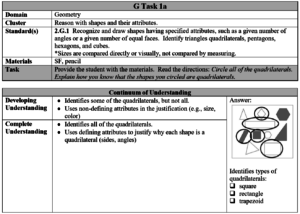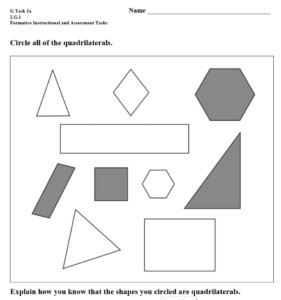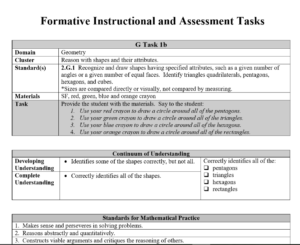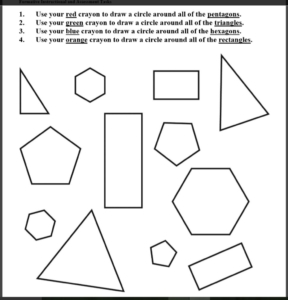MAFS.2.G.1.1 Recognize and draw shapes having specified attributes, such as a given number of angles or a given number of equal faces. Identify triangles, quadrilaterals, pentagons, hexagons, and cubes.
Cognitive Complexity Level: 1-Recall
[divider] [/divider] Students are able to…
- Find and describe two and three-dimensional shapes in their environment.
- Use precise vocabulary to describe attributes of shapes.
- Explain similarities and differences of two and three-dimensional shapes.
[divider] [/divider] Students are able to…because teachers:
- Provide time for students to explore and describe various shapes. These shapes should include regular and non-regular shapes.
- Provide students with shapes in a variety of orientations.
- Give students opportunities to create shapes when given specific attributes.
- Provide time for students to discuss two and three-dimensional shapes, while expecting students to use precise vocabulary. (vertex instead of corner, side instead of line (2-d), edge instead of line (3-d)
- Provide opportunities for students to sort shapes by given categories. Also give students the opportunity to sort shapes using their own rule and have others try to guess it.
[divider] [/divider] Questions to ask students:
- Ask: Give the student a set of 2-d shapes, including triangles, quadrilaterals, pentagons, and hexagons, and ask them to sort them by the number of sides and vertices. Then have them name each group of shapes.
- Sample answer that would indicate understanding: The student is able to sort the shapes and then correctly name each group by the number of sides and vertices.
- Sample answer that indicates an incomplete understanding or a misconception: The student may be able to sort the shapes correctly but struggles naming each set of shapes according to the number of sides and vertices.
- Ask: Ask the student to draw you a picture of a pentagon. Have them explain why it is a pentagon.
- Sample answer that would indicate understanding: The student correctly draws a pentagon and then explain that it is a pentagon because it has 5 sides and 5 vertices.
- Sample answer that indicates an incomplete understanding or a misconception: The student does not draw a 5 sided shape or is unable to explain what makes it a pentagon.
[divider] [/divider] Additional Resources:
Additional in depth content knowledge
[divider] [/divider] Sample Formative Assessment Tasks:
[divider] [/divider] Resources/Tasks to Support Your Child at Home:
Matching Shapes is an interactive matching game allowing students to identify shapes and match them with their names based on attributes: http://bit.ly/2PCROEx
Two Dimensional Shapes uses precise vocabulary to teach students about attributes of two dimensional shapes and their names: http://bit.ly/2J2OWy7
Play I-Spy with shapes in the car or at home. Try using defining attributes in your descriptions and have your child guess the shape you are describing using its name. Street signs are made up of geometrical figures, so are tile floors!
Students can use this online Geoboard to draw two-dimensional shapes. Your child can make quadrilaterals, pentagons, or hexagons. To make the game challenging, turn your shape name into a riddle. Ex: I’m thinking of a shape with 4 vertices and 4 sides. Create my shape: http://bit.ly/2yLrSzg



